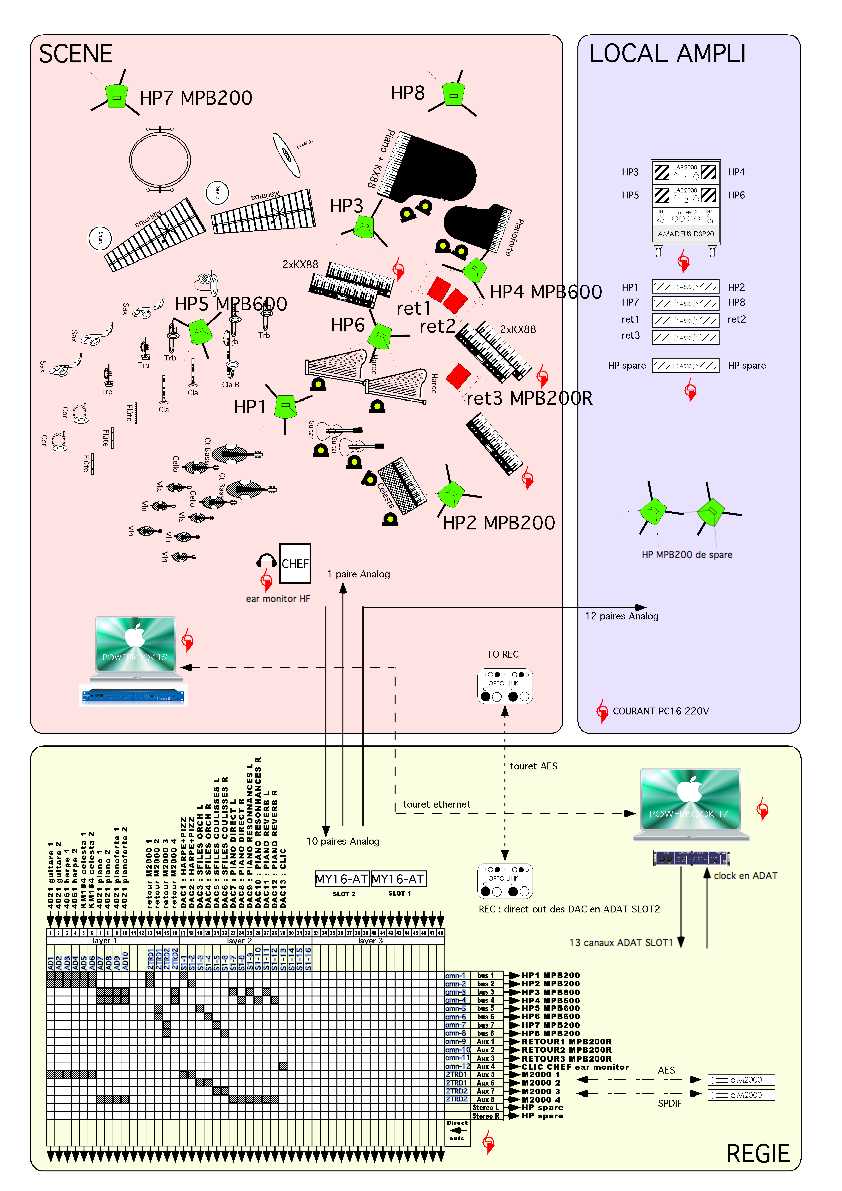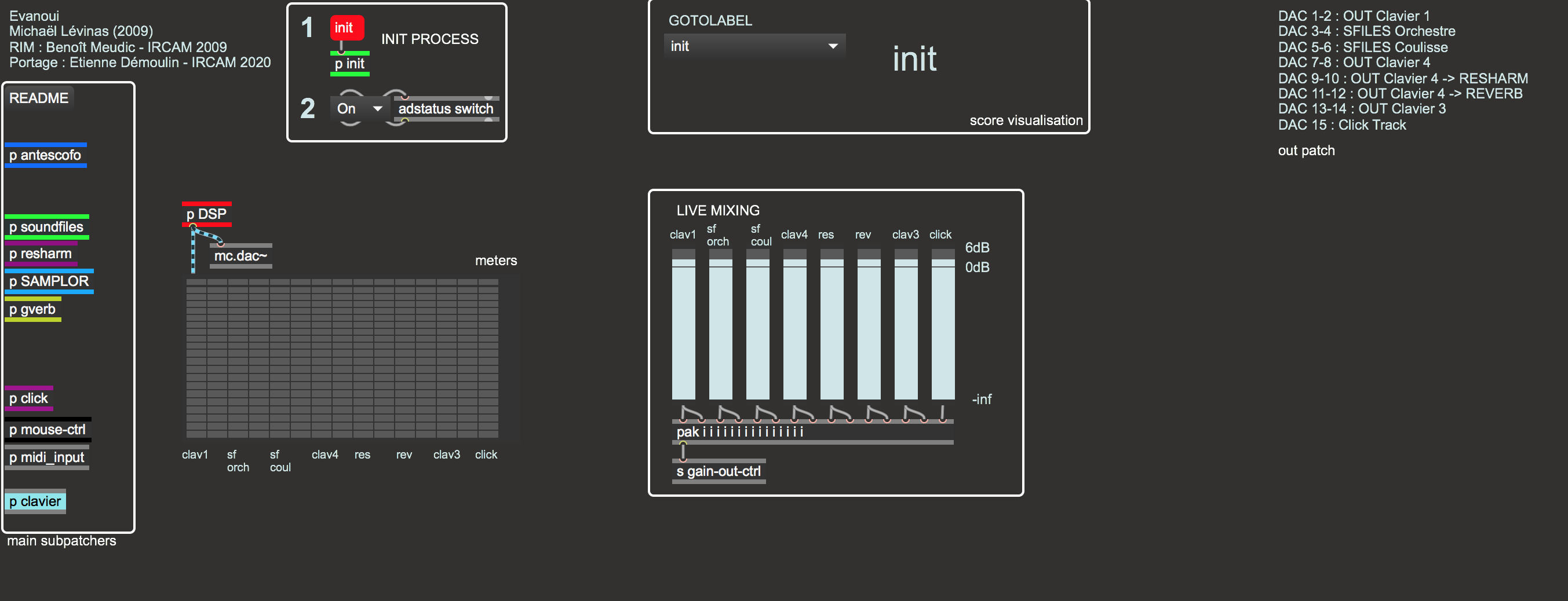Table of contents
Documentation date: 6 avril 2020
Version state
Valid
Validation date: 8 avril 2020
Version documentalist
- demoulin (Etienne.Demoulin@ircam.fr)
Version realisation
- Maxime Le Saux (Sound engineer)
- Etienne Démoulin (Computer Music Designer)
- Benoit Meudic (Computer Music Designer)
Version length
14 mnUpgrade Motivation
Upgrade for Max8.
Simplification of the patch for distribution.
Comment
Ported to Max8 but not yet tested in concert
Detailed staff
- 3 flûtes (aussi 2 flûtes altos, 1 flûte basse [toutes amplifiées] ), 1 saxophone ténor, 1 saxophone baryton, 1 saxophone basse, 2 clarinettes, 1 clarinette basse, 2 cors (aussi 2 caisses-claires [vibrantes, abouchés aux 2 cors] ), 2 trompettes [abouchées aux deux cors] , 3 trombones complets (aussi 1 trompette basse [abouchée au tuba] ), 1 tuba, 2 marimbas (aussi 1 grosse-caisse, 1 tam-tam), 1 pianoforte [type copie Clark 1820 à 435 Hrtx, amplifié] , 2 harpes [accordées à 449 hrtz] , 2 guitares [accordées à 458 hrtz, amplifiées] , 5 claviers électroniques/MIDI/synthétiseurs [3 clavieristes] , 1 piano [accord 442 hrtz] , 1 célesta, 12 violons, 10 violons II, 8 altos, 6 violoncelles, 4 contrebasses
Electronic equipment list
Computer Music Equipment
-
2 MacBook Pro - Apple Laptops
(Apple)
Main computer, OS >= 10.13 -
1 RJ 45 Cable - Cable
for osc communication between computer on stage and main computer -
2 Max 8 - Max
(Cycling74)
-
1 Fireface 800 - Sound Board
(RME)
-
5 KX 88 - MIDI Keyboard
(Yamaha)
-
1 BCF 2000 - MIDI Mixer
(Behringer)
-
1 Footswitch / Sustain Pedal - Footswitch / Sustain Pedal
for the 'clavier4' -
1 Midi interface - MIDI Interfaces
on stage
Audio Equipment
-
8 Loudspeaker - Loudspeakers
see document LEVINAS_technique.pdf for repartition -
1 ear-monitor - Headphones
for click-track (used in the second part of the piece) -
1 Digital Mixing Desk - Digital Mixers
Work related information
Premiere
- 6 mars 2009, Radio France, festival Présences
Publisher :
- Lemoine
Realisation
- Benoît Meudic
Work length
- 20 mn
Useful links on Brahms
- Évanoui pour un double orchestre (2009), 20mn
- Michaël Levinas
| File | Author(s) | Comment | |
|---|---|---|---|
| Download [35,5 Kio] | Document declenchements.pdf | ||
| Download [871,3 Mio] | Patch evanoui-2020.dmg |
Instructions
Stage setup
The instruments are distributed in two groups (two orchestras). See document LEVINAS_technique.pdf for full information. The disposition that was adopted for the creation was inversed left-right when compared to the document.

Loudspeakers set-up:
The disposition of the loudspeakers is provided in the document ‘LEVINAS_technique.pdf’.
HP1 and HP2 are used for amplifying guitars and harps.
HP3 and HP4 are used for the diffusion of midi keyboards (clavier1, clavier3 and clavier4).
HP5 and HP6 are used for soundfiles ‘coming from the orchestra’.
HP7 and HP8 are used for soundfiles ‘coming from the backstage’ (event 84, 106, 123 and 166 - see document ‘repartition-soundfiles.txt’).
Introduction to the electronic part:
The electronic relies on 5 midi keyboards that trigger orchestral samples and soundfiles. The keyboards are distributed to 3 players:
‘clavier1’ plays two keyboard (one for viola pizzicatos samples and one for harp samples)
‘clavier3’ plays two keyboards (one for viola pizzicatos samples and one for harp samples)
‘clavier4’ plays one keyboard (piano samples and soundfiles).
To trigger to soundfiles, the instrumentist has to keep pressed the highest key (midi 108), then pressing the successive chromatic keys from C4 (midi 60) to A#5 (midi 82) will respectively trigger events (soundfiles) from bar 78 to 181. The score containing the keys that must be played by ‘clavier4’ for trigerring soundfiles is not included in the main score. You can edit and print it from the file evanoui/doc/declenchements.pdf. Don’t forget to give it also to the instrumentist and to the conductor.
Note: in the score, ‘clavier2’ is the name for the acoustic piano (442 Hz), and ‘pno’ is the name for the pianoforte
Some instruments also need to be amplified:
orchestra I: pianoforte, guitars, acoustic piano, harps
orchestra II: flutes
Patches installation:
On the main computer, you must launch:
‘_MAIN_EVANOUI’, this is the main patch. It is used for playing soundfiles and for adding resonnances to the ‘clavier4’ (piano samples) signal output.
set manual IP adress to 192.168.0.1 and submask to 255.255.255.0
On the computer on stage, you must launch 1 patch with Max8:
‘evanoui-mergermidi’ converts the midi keyboards input to osc and send the messages to the main computer.
set manual IP adress to 192.168.0.2 and submask to 255.255.255.0
Main computer:
Inputs/Outputs of the computer:
There are no inputs.
There are 15 outputs: respectively ‘clavier1’ (channels 1-2), ‘sfile orchestre’ (channels 3-4), ‘sfile coulisse’ (channels 5-6), ‘clavier4’ (channels 7-8), ‘clavier4-resonnance’ (channel 9-10), ‘clavier4-reverb’ (channel 11-12), ‘clavier2’ (channels 13-14), and ‘click-track’ (channel 15)
Installation:
Copy the folder ‘evanoui’ on your hard disk. Launch Max8, and select this folder (and only this one) in the ‘file preferences’ menu of Max.
In order to test connection between computers, open terminal and type : ping 192.168.0.2. The answer should look as :

Open the patches ‘_MAIN_EVANOUI’ in Max8.

To Initialize:
1. Set Buffer size and I/O Vector size to 64, sampling rate to 44100.
1. Click on ‘init’.
2. Turn the DAC on
3. Check connection with the patcher on stage (you can use ping or ask the player to test).
3. Trigger the first event with space bar (event 0) before the concert starts. Check the click-track with the conductor (there is a toggle to start and stop it). During the concert, the click-track is automatically started on event 78 and stopped on event 181 (triggered by ‘clavier4’).
Computer on stage:

Copy the file ‘evanoui-mergermidi’ on your hard disk.
Launch the file in Max8.
To initialize the patch:
1. choose the midi input for each of the keyboards (clavier1-1 stands for the viola piz samples, clavier1-2 stands for the harp samples and so on…).
Mixing instructions:
You can map a BCF2000 or Mira to the live mixing faders.
The levels of the keyboards should always be balanced with the acoustic instruments, in order to mix equally the timbres.
The level of the soundfiles should also be balanced. The soundfiles with a ‘marimba’ sound should be loud, and the soundfiles sent to the ‘coulisse-loudspeakers’ (bar 84, 106, 123 and 166) should appear as distant from the stage.
© IRCAM

This documentation is licensed under a Creative Commons Attribution-NonCommercial-NoDerivatives 4.0 International License.
Program note
L'écriture de cette partition est basée sur une polyphonie-timbre. Cette polyphonie-timbre est obtenue par des superpositions de tempi faisant évoluer des processus harmoniques et des agrégats complexes. Ces processus évoluent en appoggiatures qui laissent percevoir le déroulement d'échelles évolutives. Ces échelles s'altèrent et se démultiplient en phénomènes octaviants et brisés. (Voir l'ouverture des [work:22287][Nègres], mon [work:23523][deuxième quatuor], [work:23532][Incurver], [work:23528][Se briser]). L'orchestre symphonique tente dans cette pièce une mutation conséquente à l'évolution des langues musicales. L'identité originaire de ce que nous appelons « l'orchestre symphonique » résulte du système tonal et de la fin de l'époque baroque européenne. Dans cette pièce, l'apparition d'un groupe instrumental spécifique basé sur différentes familles de « cordes pincées », le pianoforte, la superposition de plusieurs diapasons, les interférences entre les sons propagés dans l'espace par l'acoustique « aérienne » des instruments (le piano notamment) et les sons instrumentaux échantillonnés, provoquent des mouvements résultants et des battements très mobiles.
Michaël Lévinas
Version documentation creation date: 6 avril 2020 19:47, update date: 6 mai 2021 15:09